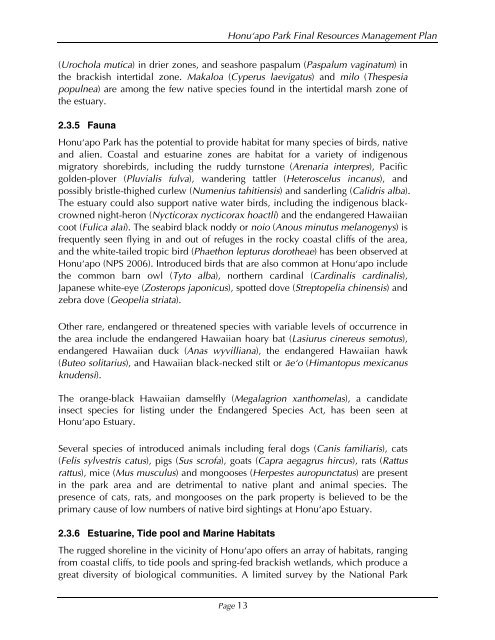Honu'apo Park Resource Management Plan
Honu'apo Park Resource Management Plan
Honu'apo Park Resource Management Plan
You also want an ePaper? Increase the reach of your titles
YUMPU automatically turns print PDFs into web optimized ePapers that Google loves.
Honuÿapo <strong>Park</strong> Final <strong>Resource</strong>s <strong>Management</strong> <strong>Plan</strong><br />
(Urochola mutica) in drier zones, and seashore paspalum (Paspalum vaginatum) in<br />
the brackish intertidal zone. Makaloa (Cyperus laevigatus) and milo (Thespesia<br />
populnea) are among the few native species found in the intertidal marsh zone of<br />
the estuary.<br />
2.3.5 Fauna<br />
Honuÿapo <strong>Park</strong> has the potential to provide habitat for many species of birds, native<br />
and alien. Coastal and estuarine zones are habitat for a variety of indigenous<br />
migratory shorebirds, including the ruddy turnstone (Arenaria interpres), Pacific<br />
golden-plover (Pluvialis fulva), wandering tattler (Heteroscelus incanus), and<br />
possibly bristle-thighed curlew (Numenius tahitiensis) and sanderling (Calidris alba).<br />
The estuary could also support native water birds, including the indigenous blackcrowned<br />
night-heron (Nycticorax nycticorax hoactli) and the endangered Hawaiian<br />
coot (Fulica alai). The seabird black noddy or noio (Anous minutus melanogenys) is<br />
frequently seen flying in and out of refuges in the rocky coastal cliffs of the area,<br />
and the white-tailed tropic bird (Phaethon lepturus dorotheae) has been observed at<br />
Honuÿapo (NPS 2006). Introduced birds that are also common at Honuÿapo include<br />
the common barn owl (Tyto alba), northern cardinal (Cardinalis cardinalis),<br />
Japanese white-eye (Zosterops japonicus), spotted dove (Streptopelia chinensis) and<br />
zebra dove (Geopelia striata).<br />
Other rare, endangered or threatened species with variable levels of occurrence in<br />
the area include the endangered Hawaiian hoary bat (Lasiurus cinereus semotus),<br />
endangered Hawaiian duck (Anas wyvilliana), the endangered Hawaiian hawk<br />
(Buteo solitarius), and Hawaiian black-necked stilt or äe‘o (Himantopus mexicanus<br />
knudensi).<br />
The orange-black Hawaiian damselfly (Megalagrion xanthomelas), a candidate<br />
insect species for listing under the Endangered Species Act, has been seen at<br />
Honuÿapo Estuary.<br />
Several species of introduced animals including feral dogs (Canis familiaris), cats<br />
(Felis sylvestris catus), pigs (Sus scrofa), goats (Capra aegagrus hircus), rats (Rattus<br />
rattus), mice (Mus musculus) and mongooses (Herpestes auropunctatus) are present<br />
in the park area and are detrimental to native plant and animal species. The<br />
presence of cats, rats, and mongooses on the park property is believed to be the<br />
primary cause of low numbers of native bird sightings at Honuÿapo Estuary.<br />
2.3.6 Estuarine, Tide pool and Marine Habitats<br />
The rugged shoreline in the vicinity of Honuÿapo offers an array of habitats, ranging<br />
from coastal cliffs, to tide pools and spring-fed brackish wetlands, which produce a<br />
great diversity of biological communities. A limited survey by the National <strong>Park</strong><br />
Page 13


